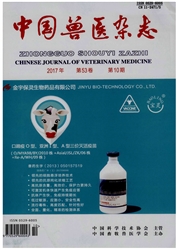

 中文摘要:
中文摘要:
为了弄清双翅目昆虫西方角蝇(Haematobia.irritans)和截脉角蝇(Haematobia.titillans)18S rDNA基因序列及其分子进化。本研究测定了两种角蝇的18S rDNA基因序列,将其在NCBI中Blast,并将序列与GenBank中已知9种双翅目昆虫的18S rDNA基因序列进行比较分析,找出它们的同源区和多变区,利用全序列和最保守同源区分别构建系统发育树。结果表明,西方角蝇和截脉角蝇18S rDNA基因序列长度均为1 984 bp,二者同源性为96.4%,存在73个识别位点。两种角蝇与GenBank中已登陆西方角蝇的同源性分别为99.1%和95.7%。11种双翅目昆虫18S rDNA基因序列中均有三段保守程度较高的同源区,分别相当于西方角蝇18S rDNA基因序列中320 bp~693 bp,848 bp~1 181 bp和1 606 bp~1 849 bp,其中第一段同源区最为保守。本文在国内外首次报道截脉角蝇18S rDNA基因序列,并证明了西方角蝇18S rDNA基因序列高度保守。利用18S rDNA基因序列中最保守同源区构建的系统发育树,对11种双翅目昆虫分类更符合传统形态学分类结果。
 英文摘要:
英文摘要:
In order to get 18S rDNA sequence and molecular evolution of diptera insects Haematobia irritans and H. titillans, we sequenced the 18S rDNA of horn flies. Then the sequence was blasted in the NCBI, and compared with the 18S rDNA of the other nine insects of Diptera in GenBank to find out their homologous regions and variable regions. Phylogenetic tree was construct- ed by using the complete sequence and the most conserved homologous regions. The results indicated that the 18S rDNA sequence length of Haematobia irritans and H.titillans was 1 984 bp. The homology between them was 96.4% and there were 73 recognition sites. The homology of the two horn flies with the H.irritans reported in GenBank was 99.1% and 95.7% respectively. There were three highly conserved homologous regions in the 18S rDNA gene sequences of 11 kinds of diptera insects, which was equivalent to the sequence from 320 bp to 693 bp, 848 bp to 1 181 bp and 1 606 bp to 1 849 bp in 18S rDNA gene sequences of Haematobia irtitans respectively, while the first section of the homologous regions was the most conservative. The 18S rDNA gene sequences of H. titiUans were reported for the first time in the world in this article, and it proved the 18S rDNA gene sequence of H. irritans was highly conserved. So it maybe more scientific to classify the 11 kinds of diptera insects by the phylogenetic tree, which was construtted by using the most conservative homologous region, than the one constructed by the whole sequence, it was in accordance with the result of the traditional morphological classification.
 同期刊论文项目
同期刊论文项目
 同项目期刊论文
同项目期刊论文
 期刊信息
期刊信息
